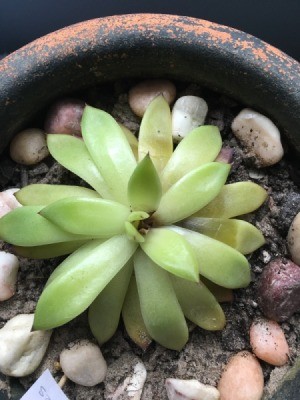 My succulent has been looking a little off lately. It's an echeveria agavoides, if that helps. Have I been overwatering? Underwatering? Not enough or too much light?
My succulent has been looking a little off lately. It's an echeveria agavoides, if that helps. Have I been overwatering? Underwatering? Not enough or too much light?
Since you know the name of your succulent then I feel sure you read care instructions (the Lipstick plant?).
My only suggestion would be to very carefully remove your plant and make sure the soil at the bottom is not wet. You can use a water instrument/gauge if you have one but be sure the point goes to the bottom of the pot.
Have you changed your watering schedule lately? Do you water more than once per month? Does your pot have good drainage and no saucer underneath?
Overwatering and underwatering both have the same characteristics so it is difficult to judge by the photo. Light could be an issue as the sun has changed and there may be less light than before.
Here is a good source of care instructions so maybe you might see something you haven't noticed before.
Succulent plants are easy to grow and take care of.
Step 1
Most succulent plants don't need a lot of water to survive.
Step 2
The plant you have should be watered once every 7 to 10 days.
Step 3
Give the plant a good soaking. Let all the excess water drip out from the bottom of the pot.
Step 4
The next time you will water the plant is when you see the dirt start to crack and look very dry.
Step 5
Even if the top of the soil is dry, don't water it again without checking the soil underneath. This soil needs to be very dry.
Step 6
Over watering succulent plants can cause root rot and the plant to die.
Step 7
You can grow this plant either inside or outside.
Step 8
I keep my succulent plants on a small table on my terrace. The plants receive moderate sunlight in the late afternoon to evening hours. I find this best for this type of plants.
Step 9
Each climate and zone is different. I would suggest that you look up your zone online and see what they suggest for this plant.
Over-watering is the most common cause of yellowing leaves on a succulent plant. Constantly wet soil can rot the plant's roots, interfering with its ability to take up water and nutrients from the soil.
Caring for echeveria agavoides.
Step 1
When you water Echeveria, water the soil and not the rosette.
Step 2
Pour on the water until it drains out the bottom.
Step 3
Repeat this a couple times.
Step 4
Then don't water again until the soil has dried out.
Step 5
Once the threat of frost has past, gradually move them back outside in the spring.
Step 6
They like full sun.
Step 7
Do not keep them in the afternoon sun if it is very hot.
Step 8
Echeveria, indoors or outside, dont like to be kept too wet, but they also dont like to be kept too dry.
Step 9
Echeveria need soil that drains quickly. This helps prevent moisture from rotting the roots.
Step 10
Getting a fresh change of soil every couple years will keep them healthy and growing well.
Step 11
Use a slow-release fertilizer at the beginning of spring, or a liquid fertilizer diluted 2-4 times more than normal and used less often than recommended.
Succulents require little care. Water the soil, until once a week or longer, depending if the soil looks dry. Some direct sunlight needed too.